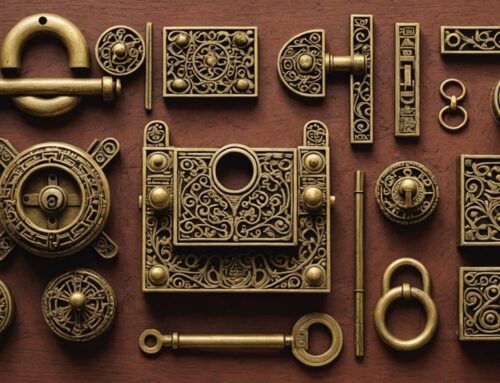You’ve done it again, haven’t you? Lost your keys and now you’re stuck outside. But don’t worry, we’ve got a surprising trick up our sleeve to help you out – lock bumping. With a regular key and some finesse, you’ll be back inside in no time. But remember, this newfound skill comes with responsibility. So buckle up, get ready to unlock this secret, and let’s ensure you’re never locked out again.
Key Takeaways
- Making a bump key involves filing down the valleys in the teeth of an ordinary key.
- To bump a lock, insert the key, pull back slightly, and turn the key in the unlock direction while hitting the back end of it.
- Bumping may not work on all types of locks, so it’s important to practice on a lock you own before attempting it on a lock you’re locked out of.
- It is recommended to consult a professional locksmith for assistance and always use lock bumping responsibly and legally.
Understanding the Mechanism of Locks
In understanding the mechanism of locks, you’re essentially delving into the intricacies of how the valleys and peaks of a key interact with the pin tumbler system, a knowledge that’s crucial when you’re making a bump key. This is where common lock vulnerabilities come into play. By exploiting these weaknesses with lock picking techniques like bumping, you’re able to manipulate the lock’s pin system to your advantage.
Now, you’re not just a bystander but an active participant in this community. You’re learning the art of lock picking, understanding its science, and identifying the common vulnerabilities. But remember, with this knowledge comes a responsibility. Use it wisely and ethically, respecting others’ privacy and property. Welcome to the world of lock picking, where you belong.
The Art of Key Making: Step by Step Process
You’ve got five main steps to follow for making a bump key, but remember, it’s not always a guaranteed method, and you should always respect the law. The key making process starts with finding a key that fits the lock. Next, identify the valleys in the teeth and file them down to their lowest point. Ensuring the teeth are level, file each valley to the same point along the key’s shaft. The different types of locks might require different keys, so keep this in mind. After making the bump key, practice on a lock you own. The final step is the bumping process – striking the back of the key with a blunt object. Remember, always use this knowledge responsibly.
The Technique of Bumping a Lock: A Detailed Guide
With the bump key you’ve made, you’re now ready to dive into the technique of bumping a lock, a process that involves precise timing and a gentle hand. This is a skill with a fascinating history, tracing back to the 1970s. The psychology behind lock security, however, is even older, rooted in our primal need for safety and belonging.
Here’s a quick guide:
- Align your bump key with the lock.
- Apply a slight turning pressure.
- Give your key a firm tap.
Legal Implications and Ethical Considerations of Bumping Locks
While lock bumping can be a useful skill, it’s crucial to understand the legal implications and ethical considerations before you attempt this technique. You’re part of a community that values responsibility, so let’s dive into the legal ramifications. Possession of a bump key can raise eyebrows, potentially leading to legal consequences, as it might be seen as intent to commit a crime. It’s essential to consult with a professional locksmith when you’re locked out rather than resorting to lock bumping. The ethical concerns are just as important. Using this technique on a lock that doesn’t belong to you without explicit permission is a breach of trust. Remember, your actions reflect on our community, so always act responsibly and legally.
The Role of a Professional Locksmith in Key Bumping
In your journey of understanding key bumping, it’s crucial to learn about the role of a professional locksmith, for they can provide you with valuable insights and ensure your actions are compliant with the law. You’re not alone in this; we’re all in it together.
- Locksmiths have in-depth knowledge about different types of locks and can guide you in lock picking.
- They adhere to a code of ethics, ensuring that their skills are used responsibly.
- Hiring a locksmith can save you the legal hassles involved in lock bumping.
Tips to Enhance Lock Security and Prevent Bumping
You’ll find tamper-proof locks to be a solid investment for enhancing your home’s security and preventing lock bumping. But don’t stop there. Be aware of electronic lock vulnerabilities. Even the most advanced systems can be prone to hacking or glitches. Regular updates and maintenance are crucial to keep them at their best. Consider hidden lock hiding places for spare keys. It’s not enough to hide them under a doormat or in a fake rock; thieves know to check these places. Think creatively, and outside the box, like in a weatherproof box in the garden or a magnetic lock box under your car. Security isn’t just about locks; it’s about being one step ahead. You’re not just protecting possessions, but your sense of belonging.
Essential Knowledge Before You Start Bumping Locks
Before you attempt to bump locks, it’s essential to arm yourself with the right knowledge and tools. It’s not just about having a bump key, you need understanding of lock mechanisms to be successful. You’re part of a community who values skill and knowledge; don’t let common mistakes in lock bumping techniques set you back.
- Be patient: Lock bumping isn’t a race, rushing can damage the lock or key.
- Apply the right amount of pressure: Too much or too little can fail the attempt.
- Practice: Mastering this technique requires time and repetition.
Advanced Tricks to Unlock More Complex Locks
Surprisingly, mastering advanced tricks can enable you to unlock even the most complex locks with ease. You’re part of a savvy group, keen on understanding lock mechanisms and avoiding common mistakes in lock bumping techniques.
Yet, it’s crucial to remember that each lock is unique, with its own set of quirks. Don’t be discouraged if a technique that worked once doesn’t work again. Instead, learn to adapt. Observe the lock’s response to your bump key. Is it stubbornly resisting? Maybe you’re applying too much force.
Real-Life Stories of Successful Lock Bumping
You’ve heard the theory and techniques, and now we’re diving into real-life stories of successful lock bumping. Let’s explore some lock bumping success stories that have made headlines:
- One famous lock picker, nicknamed “The Keymaster”, reportedly used the bumping technique to open a high-security lock at a renowned bank, leading to significant advancements in lock technology.
- Another story involves a group of students who used lock bumping to test the security of their school, bringing awareness to the vulnerabilities of traditional locks.
- Finally, a locksmith once demonstrated the effectiveness of bumping by opening a supposedly ‘unpickable’ lock at an industry expo.
These stories serve as a reminder of the power of this technique, encouraging us to learn, adapt, and foster a sense of belonging in the lock picking community.
Frequently Asked Questions
What Materials Are Typically Used to Make a Bump Key?
You’ll typically use a regular key and a file to make a bump key. Remember, while the history of bump keys is fascinating, it’s crucial to understand the legality of using them. Always respect others’ privacy.
Is Lock Bumping Considered a Skill That Requires Extensive Practice to Perfect?
Yes, lock bumping is an art that requires practice to perfect. It’s similar to learning a musical instrument. However, consider bumping legality and ethics. It should only be used responsibly and within legal boundaries.
Are There Specific Types of Locks That Are More Resistant to Bumping?
Yes, there are locks with Bumping Resistance Features. Anti Bumping Lock Innovations like high-security, pin tumbler, and disc-detainer locks are tougher to bump. You’d feel more at home knowing your locks are bump-resistant.
Can Lock Bumping Cause Damage to the Lock Itself Over Time?
Yes, lock bumping can gradually wear down your lock’s inner workings. Think of it as a storm battering a cliff – over time, it erodes. This bumping impact analysis reveals lock durability concerns.
What Are Some Alternatives to Lock Bumping for Unlocking a Door Without the Key?
You can explore other methods besides lock bumping. For instance, learning various lock picking techniques can be handy. Alternatively, consider using keyless entry systems for a more tech-savvy and secure solution.








